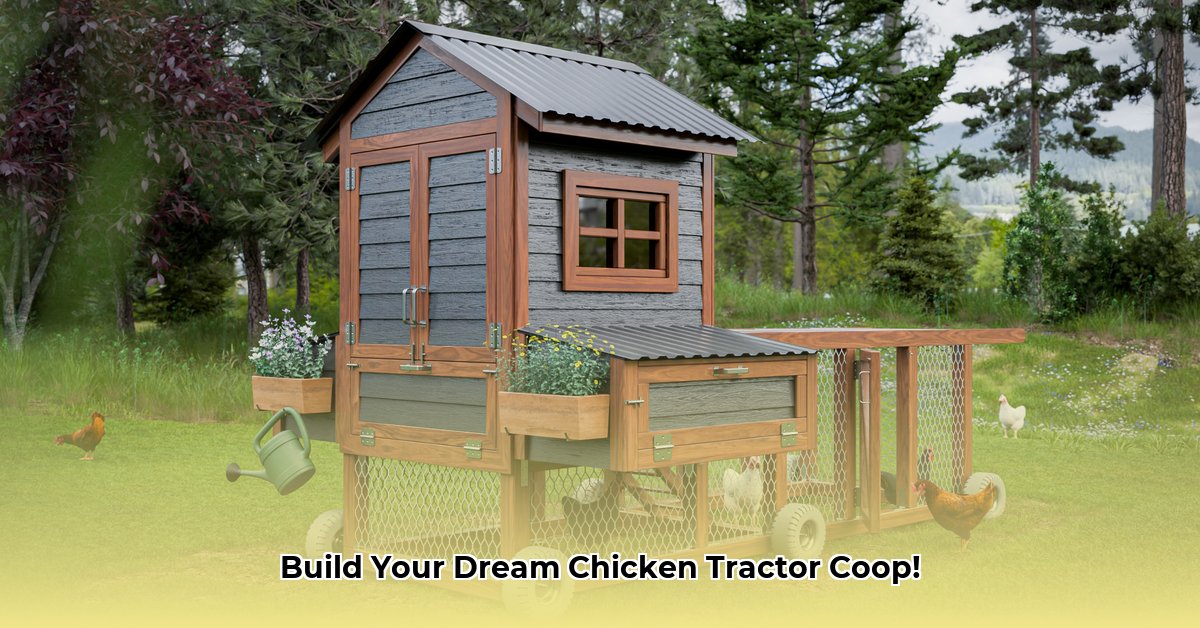
Raising chickens offers fresh eggs and the satisfaction of sustainable farming. A mobile chicken coop, or chicken tractor, simplifies this process by providing fresh pasture daily. This comprehensive guide covers everything from design and selection to construction and maintenance, empowering you to build or buy the perfect coop for your needs. For detailed DIY plans, check out these helpful resources.
Understanding Chicken Tractor Coop Design
A chicken tractor is a portable coop, allowing you to move chickens to fresh grazing areas. Key components include a frame (often wood or metal), wire mesh walls (providing ventilation and basic predator protection), a slatted wood floor (for easy cleaning), wheels for mobility, and a run for foraging. Material selection impacts cost and maintenance; wood is affordable but requires upkeep, while metal offers durability at a higher price. Crucial design elements include adequate ventilation (essential for preventing respiratory issues), robust predator protection (consider hardware cloth, electric netting, or guardian animals), and ease of cleaning. Size should accommodate your flock and allow for comfortable movement.
Choosing the Right Chicken Tractor Coop
Selecting the right coop involves several key factors. Firstly, consider your flock size and the space needs of your chosen chicken breed. Climate significantly impacts design; hot climates need ventilation, while cold climates require insulation. Available space in your yard dictates the coop's size. Finally, budget considerations narrow down your options between DIY and commercially available coops. Building your own provides customization but demands time and skills; pre-made coops offer convenience but limit design choices. Did you know that a well-designed coop can significantly reduce disease risk among your flock?
DIY vs. Commercial Coops: A Comparison
The choice between DIY and commercial coops hinges on your skills, time, and budget. DIY offers significant cost savings and complete customization. However, it requires carpentry skills and a substantial time investment. Commercial coops are more expensive upfront but save time and often come with warranties.
| Feature | DIY | Commercial |
|---|---|---|
| Upfront Cost | Lower | Higher |
| Time Investment | High | Low |
| Customization | High | Low |
| Skill Required | Moderate to High | Low |
| Maintenance | Owner-responsible | Warranty may cover some repairs |
Building Your Own Chicken Tractor: A Step-by-Step Guide
Building your own chicken tractor is a rewarding experience. Follow these steps for a successful project:
Planning & Design: Sketch your coop, determining dimensions and features based on your flock size, climate, and predator concerns. Consider ventilation and ease of cleaning.
Gather Materials: Acquire all necessary materials, including lumber, hardware cloth (minimum 1/2 inch mesh for predator protection), hinges, heavy-duty casters, and fasteners. A detailed materials list is crucial.
Frame Construction: Build a sturdy frame, ensuring square corners and strong joints. Use pressure-treated lumber for durability.
Walls & Flooring: Attach hardware cloth to the frame, ensuring a secure fit to prevent predator entry. Install a slatted wooden floor for easy cleaning.
Run Construction: Build a spacious run, securely attaching it to the coop.
Wheel Installation: Attach heavy-duty casters to the frame, ensuring they can support the coop's weight.
Final Touches: Add roosting bars, nesting boxes (optional), a secure door, and any other desired features.
Buying a Pre-made Chicken Tractor: A Guide to Smart Shopping
Purchasing a pre-made coop simplifies the process. Research reputable manufacturers and read customer reviews. Prioritize coops built with durable materials, ensuring adequate ventilation and predator-resistant design. Check warranty information and compare pricing. Consider how easily the coop can be cleaned.
Predator Protection Strategies: Keeping Your Flock Safe
Predator protection is paramount. Use heavy-gauge hardware cloth (minimum 1/2-inch mesh) for walls and runs. Electric netting adds an extra layer of security. Consider a guardian animal like a dog or llama. Secure the coop's design to minimize vulnerabilities. Regular inspection is key to preventing potential breaches.
Maintenance & Troubleshooting: Ensuring Coop Longevity
Regular cleaning is essential (at least weekly) to prevent disease and pest infestations. Inspect the coop regularly for damage and repair promptly. Address ventilation and drainage issues immediately. Monitor your flock's health and address any concerns swiftly.
Legal and Regulatory Considerations: Checking Local Ordinances
Before acquiring chickens, check local zoning laws, permit requirements, and flock size limits. Compliance with local ordinances is essential. Contact your local authorities for guidance.
Conclusion: Embark on Your Poultry-Raising Journey
Chicken tractors offer a sustainable and efficient way to raise chickens. Whether you build or buy, you'll enjoy fresh eggs and the satisfaction of providing quality care for your flock. Start planning your chicken paradise today!